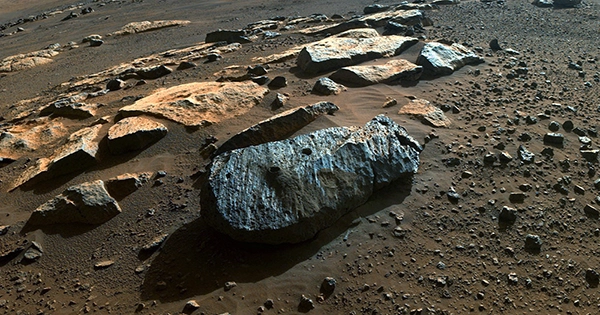Strange rock formations seen by NASA’s Spirit rover in Gusev Crater, and more recently by Perseverance in Jezero Crater, are thought to be the product of catastrophic explosive eruptions from enormous and ancient volcano calderas, according to researchers. The possibility of olivine-rich bedrock on Mars has long been a source of speculation. Olivine is a silicate mineral that forms from lava. Although Mars has a history of volcanism, including the Solar System’s largest volcano, Olympus Mons, it remained unclear how these deposits developed. From lava flows to violent impacts to unleashing magma from the mantle itself, anything is fair game.
According to a study published in the journal Icarus, a research team led by Arizona State University’s Steve Ruff believes the deposits are also rich in ignimbrite, a form of rock that is both volcanic and sedimentary. Pyroclastic debris thrown from violent volcanic eruptions forms ignimbrite rock, Spirit’s Microscopic Imager captured some unusual photographs that revealed striking resemblance to these sorts of rocks on Earth. In a statement, Ruff stated, “That eureka moment.” “I was noticing textures in the rocks of Gusev crater that were similar to those in a very specific type of volcanic rock found on Earth.”

Ignimbrite is a difficult rock to create. On Earth, it is formed by massive volcanic explosions that dump pyroclastic ash, pumice, and other materials in dense layers over a short period of time. “Imagine a ground-hugging cloud of hot gases and practically molten ash and pumice streaming for dozens of kilometers and stacking up in layers up to hundreds of feet thick in only a few days,” Ruff said.
After the eruption, the hot deposits cool down over months and years, forming cooling cracks. Patterns in olivine-rich rocks on Mars are strikingly similar to those observed in ignimbrite rocks in Yellowstone National Park. “Ignimbrites have never been proposed as an explanation for olivine-rich bedrock on Mars,” Ruff stated. “And it’s probable that this is the type of rock that the Perseverance rover has been driving around on for the past year, sampling.” On Earth, the most recent ignimbrite deposits aren’t very rich in olivine, but some of the oldest ones are, so it’s plausible that this is also true on Mars. Perseverance has gathered materials that will be returned to Earth in a future mission, allowing for a definitive test of this concept.















